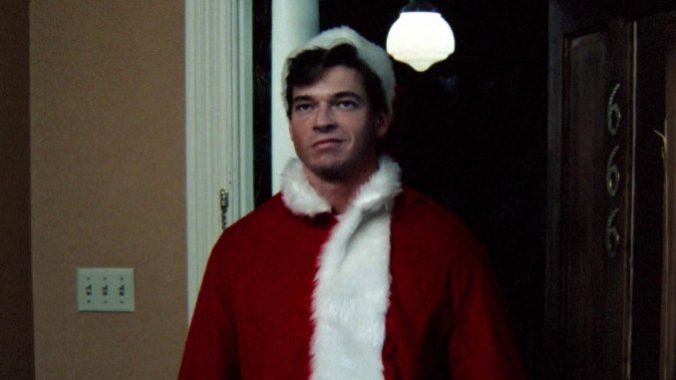We’re Not Giving Silent Night, Deadly Night Part 2 Enough Credit

So-bad-it’s-good movies aren’t often associated with Christmas, but then you remember how many cheap Christmas horror films have been made, and the Venn diagram starts to take shape. The most iconic crappy Christmas flick is undoubtedly Silent Night, Deadly Night Part 2, in no small part due to a 20-second viral clip where an ordinary man is taking out the trash, only for a sweater-clad gentleman to pull a gun on him, yell what we can only imagine is his pro-wrestling finishing move (much to the internet’s pleasure) and blow the man away. The man finds the whole affair as amusing as the audience, as he chuckles to himself in the aftermath. It’s impossible to tell this clip is from a Christmas-themed movie by watching it in isolation.
Silent Night, Deadly Night Part 2 feels like both barely a movie and also a prank on its audience. The first Silent Night, Deadly Night (or, SNDN) is a low-budget but competently assembled slasher tracing the psychosis that overwhelms a young man, Billy, growing up under punishing nuns after his parents were killed by a murderous Santa Claus. You can’t appreciate how influential Psycho was to the horror genre until you see a million inferior clones taking a broad stab at what they think child psychology is, but for playing a stock insane killer, Robert Brian Wilson hands in a pitch-perfect performance, grounding it with enough realism but unafraid to go loony every time he sees red—often prompted by sex and nudity.
It should be said, I have not seen Silent Night, Deadly Night, but Part 2 features about 30 minutes of reused footage from the first film. It’s framed by a recap from Billy’s younger brother Ricky (Eric Freeman) while he’s locked up in an institution for following in Billy’s murderous footsteps. You know how it is with brothers at Christmas; if Billy gets a kill count, then it’s only fair that Ricky gets one too.
It’s only fair that Part 2 went viral for Eric Freeman’s delirious performance. He is, and I’m putting this lightly, the finest comic actor of the 20th century. Freeman plays Ricky as a man who looks suspicious of his own face, twitching and staring with unfettered intensity. And the delivery! His intonation sounds like the exact inverse of how normal actors would speak. When Ricky gets his shot at being weird and murder-y, each kill seems to feed him a dark cosmic energy, so by the end he has a presence of a violent superhuman. There is absolutely no way to actively attempt to act like this; it’s the type of glorious oddity one can only achieve accidentally.
But there’s the catch—why are we so quick to assume every one of Part 2’s joys are accidental? So-bad-it’s-good is one of those genres that says more about the audience experience than actual filmmaking style or tone; it threatens to omit whole swathes of performance or directorial choices with the assumption that they’re all failures. Just because something in a film is not conventionally “good” doesn’t mean it was created through incompetence. Part 2’s camp brilliance is a product of astute filmmaking decisions with a very limited array of options.
-

-

-

-

-

-

-

-

-

-

-

-

-

-

-

-

-

-

-

-

-

-

-

-

-

-

-

-

-

-

-

-

-

-

-

-

-

-

-

-








































